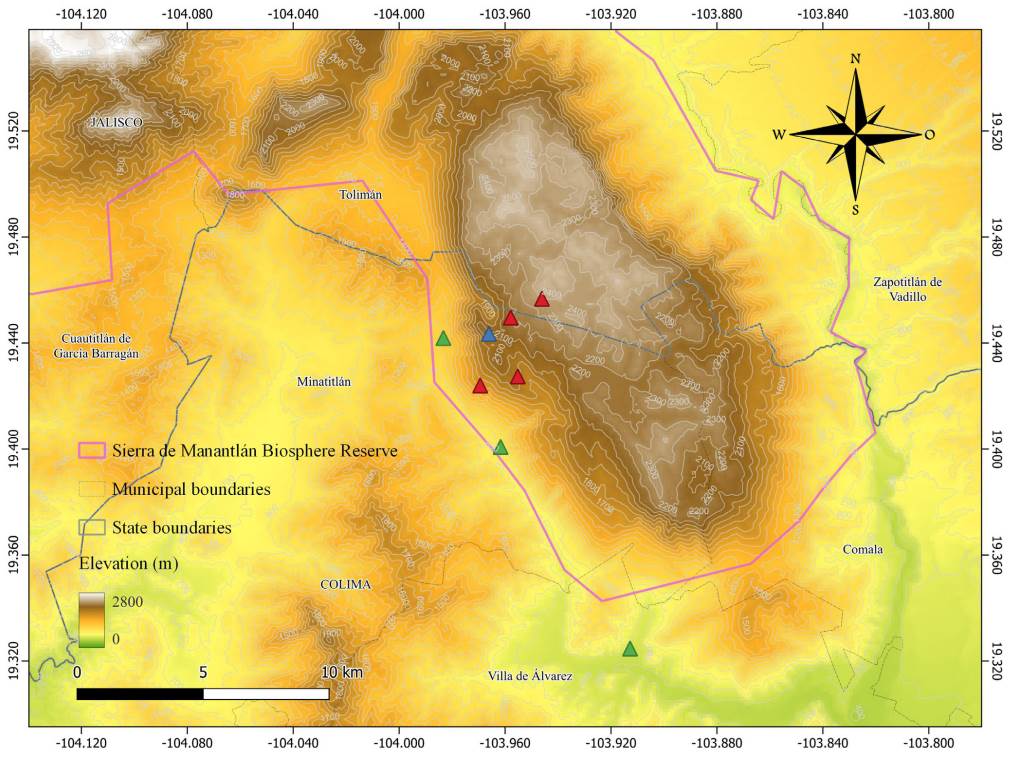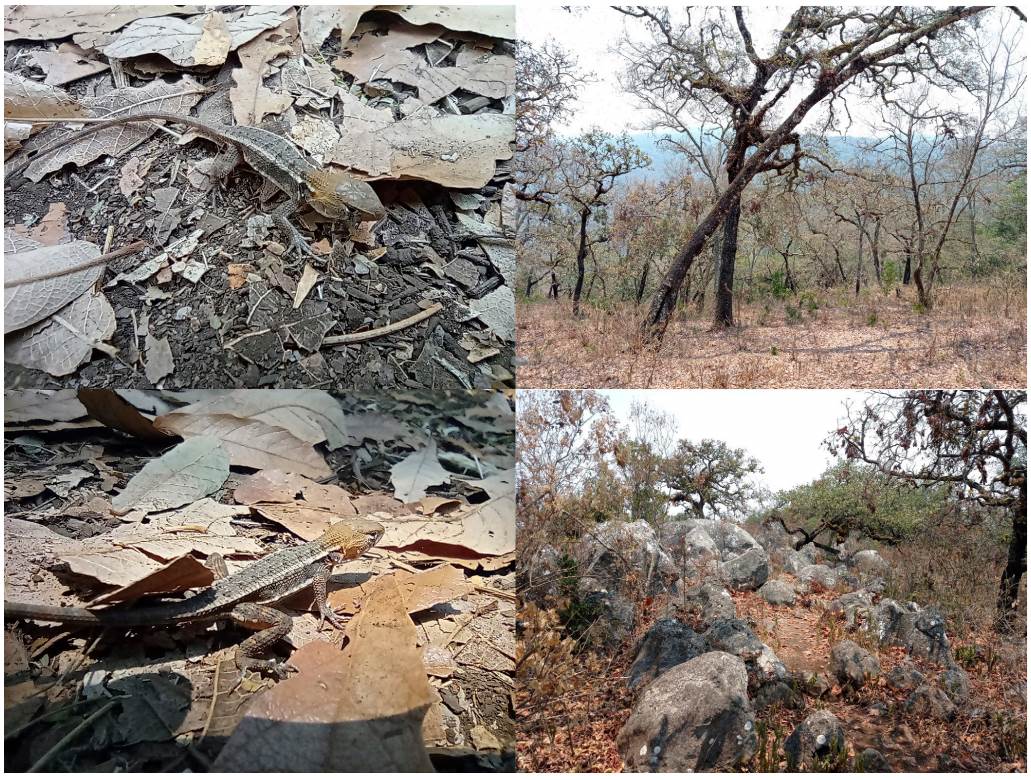Cope's Largescale Spiny Lizards (Sceloporus utiformis Cope, 1864) It is a Mexican endemic species distributed along the Pacific are slender-bodied, medium-sized lizards (SVL ≈ 70 mm) with slope in the states of Sinaloa, Nayarit, Zacatecas, Jalisco, Colima, a tail more than double their body size and with an oviparous Michoacán, Guerrero, and Morelos, where it can be found in mode of reproduction (García & Ceballos, 1994; Heimes, 2022). leaf litter, low bushes, and rocks in tropical deciduous, semi-deciduous, oak, oak-pine, and pine-oak forests (Saldaña de la Riva & Pérez Ramos, 1987; García & Ceballos, 1994; Castro-Franco & Bustos Zagal, 2004; Uetz et al., 2022). This species is known to occur from sea level up to nearly 1,800 m a.s.l. (Saldaña de la Riva & Pérez Ramos, 1987; Köhler & Heimes, 2002; Heimes, 2022). Here, we expand this range based on the finding of two individuals of S. utiformis in the southeastern portion of the Sierra de Manantlán, known as Cerro Grande. This area, spanning from ca. 650 to 2,460 m elevation, differs from the rest of the Manantlán mountain massif by its primarily karstic composition (Martínez et al., 1998). Along its elevational gradient, Cerro Grande harbors six main vegetation types (tropical deciduous forest, tropical sub-deciduous forest, gallery forest, montane cloud forest, oak forest, and pine forest), as well as areas of mixed and secondary vegetation (Vázquez & Givnish, 1998; INEGI, 2021).
On May 20th, 2022, between 12:57 and 13:34 h (GMT-5), while conducting a herpetological survey at the western slope of Cerro Grande, we found two female individuals of S. utiformis along a trail that takes to the viewpoint known as El Filete, in the locality of El Terrero, Minatitlán, Colima (19.443° N, 103.966° W; datum = WGS84; 2,154 m a.s.l.; Fig. 1). Habitat at this site consisted of oak forest with a relatively shallow layer (< 50 cm) of leaf litter, herbaceous elements, and rocky outcrops (Fig. 2). We recorded snout-vent length (SVL) and tail length of the organisms, using a digital caliper (± 0.01 mm), body mass, with a digital scale (± 0.1 g), as well as field body (cloacal) temperatures (Tb), air temperatures (Ta, 3 cm above perching site), and substrate temperatures (Ts) where the organisms were first spotted, using a Fluke 51-II digital read-out thermometer with a K-type thermocouple (± 0.01 °C). Both individuals were found in leaf litter.

Figure 1 Map of the area of Cerro Grande displaying locations where Sceloporus utiformis were recorded (green triangles) and were not recorded (red triangles) in Loeza Corichi (2004), as well as the new elevational record (blue triangle).
Figura 1 Mapa del área de Cerro Grande que muestra los sitios donde Loeza Corichi (2004) registró Sceloporus utiformis (triángulos verdes), sitios donde no registró la especie (triángulos rojos) y el nuevo registro altitudinal (triángulo azul).

The first individual had a SVL of 37 mm, a tail length of 65.9 mm, and a body mass of 1.6 g, with a Tb of 33.8 °C, a Ta of 28.2 °C, and a Ts of 31 °C. The second one had a SVL of 39 mm, a tail length of 68.6 mm, and a body mass of 1.6 g, with a Tb of 34.1 °C, a Ta of 22 °C, and a Ts of 25.8 °C. Neither of them showed indications of caudal autotomy or regeneration. After taking these measurements, we released back the individuals at the point where we caught them.
Ours represents the highest known record of S. utiformis so far (Table 1). Previously, the uppermost record consisted of that of Saldaña de la Riva and Pérez Ramos (1987), who reported the species to be present in the vicinity of Coatepec de la Escalera, in Guerrero, at 1,775 m a.s.l. Hence, our finding extends the known elevational range of S. utiformis by 380 m. Notably, Loeza Corichi (2004) carried out, from 1994 to 1995, monthly samplings to study the structure of the herpetofaunal assemblage of Cerro Grande along its elevation gradient. She found this species to be present up to 1110 m. Therefore, the occurrence of S. utiformis over 1,000 m above where it was found almost three decades ago at the same locality poses a remarkable finding, as it would imply a mean upward shift of almost 40 m per year.
Table 1 Highest elevational records of the lizard Sceloporus utiformis. Vegetation: OF = oak forest; OPF = oak-pine forest; POF = pine-oak forest; TDF = tropical deciduous forest.
Tabla 1 Registros altitudinales mayores de la lagartija Sceloporus utiformis. Vegetación: OF = bosque de encino; OPF = bosque de pino-encino; POF = bosque de pino-encino; TDF = bosque tropical caducifolio.
| Locality | Latitude | Longitude | Elevation (m) | Vegetation | Source |
|---|---|---|---|---|---|
| Cerro Grande, Minatitlán, Colima | 19.4435 | -103.9661 | 2154 | OF | This study. |
| Coatepec de la Escalera, Leonardo Bravo, Guerrero | 17.74 | -99.85 | 1775 | OF, OPF, POF | Saldaña de la Riva & Pérez Ramos (1987) |
| Agua Zarca, Mixtlán, Jalisco | 20.6444 | -104.5556 | 1654 | POF | Williams & Arce (2021) |
| Sierra Los Huicholes, Bolaños, Jalisco. | 21.8747 | -103.8206 | 1615 | OF | Ahumada-Carrillo et al. (2020) |
| Uruapan, Michoacán. | 19.38 | -102.06 | 1600 | OF | Smith (1939) |
| Cerro Frío, Tilzapotla, Morelos | 18.4519 | -99.2688 | 1411 | OF | Castro-Franco & Bustos Zagal (2004) |
| Mezquital del Oro, Zacatecas | 21.2277 | -103.3700 | 1230 | TDF | Ahumada-Carrillo et al. (2011) |
| Cerro Grande, Minatitlán, Colima | 19.4419 | -103.9833 | 1110 | TDF | Loeza Corichi (2004) |
Across its range, S. utiformis is a rather conspicuous element within lizard assemblages (García & Cabrera-Reyes, 2008; Sicileo-Cantero et al., 2016), so it is unlikely that the species has passed undetected during previous samplings. As elevational range shifts are expected to happen due to increasing global temperatures (Bonino et al., 2014; Sillero, 2021), it is not unreasonable that this new record could be a case of such phenomenon. If so, the upslope change observed for this species at Cerro Grande would be one of the highest recorded among amphibians and reptiles (Raxworthy et al., 2008).
Moreover, few oviparous members of the genus Sceloporus are found at elevations above 2,000 m (Méndez-de la Cruz et al., 1998, 2013; Díaz de la Vega-Pérez et al., 2022), due to thermal and metabolic constraints on reproduction (Domínguez-Guerrero et al., 2022). In this regard, a comparison of the life-history traits, physiological ecology, and reproductive biology of lowland and highland populations of S. utiformis might provide valuable insights into the implications of oviparity along elevation gradients and on the effects of climate change on reptiles.











 nova página do texto(beta)
nova página do texto(beta)


